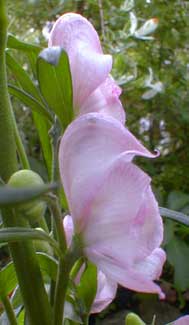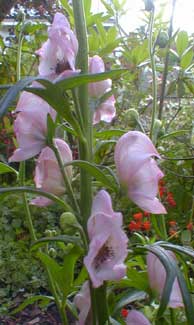
'Pink Sensation'
Wolf's-bane or Monkshood
"No, no! go not to Lethe, neither twist
Wolf's-bane, tight-rooted, for its poisonous wine;
Nor suffer thy pale forehead to be kissed
By nightshade, ruby grape of Proserpine."
-John Keats
(1795-1821)
(1795-1821)
'Pink Sensation' is a recent cultivar bred by Piet Oudolf of the Netherlands, author of such books as Planting the Natural Garden (2003), an advocate of the "New Wave" school of gardening which attempts to give gardens a wild & woodsy feeling even while employing landscape design techniques.
 His cultivar was bred from the bicolor monkshood (Aconitum cammarum) & Carmichael's monkshood (A. carmichaelii, aka A. fisheri). Heralded as "a color breakthrough for monkshoods," it has powder-pink or silvered-pink helmet-flowers shown here in June photographs.
His cultivar was bred from the bicolor monkshood (Aconitum cammarum) & Carmichael's monkshood (A. carmichaelii, aka A. fisheri). Heralded as "a color breakthrough for monkshoods," it has powder-pink or silvered-pink helmet-flowers shown here in June photographs.Each bloom has a dark throat visible under the hood but not visible to casual observation. Upright flowering stems reach four or five feet of height & rarely need staking. The glossy basal leaves are deeply cut dark-green half-dropping feathers.
'Pink Sensation' wants persistently moist well-draining soil in a sunny location or very slightly shaded; it will not bloom well in much shade. Propagation is by division every few years, though an established clump never really likes disruption. 'Pink Sensation' does not grow true from its seeds.
Besides the best-known common names Aconite, Monkshood, or Wolf's-bane, this is a perennial that has acquired along the centuries a grand array of folk names. Monkshood flowers were said to resemble a chariot, so that it was sometime's called King's Coach, but also Venus's Chariot or Cupid's Car, an association made either because the flowers were thought to resemble the doves that pulled Aphrodite's chariot, or because witches were believed to use monkshood in their most popular product, love potions. Because these love potions could kill the object of one's affection, the plant was also known as Witch's Bane or Mourining Widow.
Many names allude to their toxicity & they were the Bane of Wolves because wolves were baited with meat laced with extract of monkshood root, or arrows were dipped in root extract before hunting wolves. So Wolfsbane was also known as Leopard's Bane, Tiger's Bane, or Dog Bane, this latter because the first monkshoods were alleged to have sprung from the drool of Hecate's hellhound Cerebus. Pliny believed monkshood, as a poltice, could negate the deadly effects of scorpion sting or snakebite, & that the very odor of the plant would kill rodents at a great distance. Hence it was amusingly called Mousebane.
The bloom was as often thought to resemble a knight's helmet, a Phrygian cap, or of course a monk's cowl. A whole array of names allude to this appearance: Friar's Cap, Friar's Cowl, Helmet Flower, Capuchon de Moine, Soldier's Cap, Storm Hat (or Stormhat), Turk's Cap, Wolf's Hat, Cuckoo's Cap, or among Germanic people, Thor's Helm. In Japan it is called Kabuto or Samurai War Helmet. In Scotland they've been known as Auld Wife's Huid (Old Wife's Hood).
And the parade of folknames goes on: Blue Rocket for the flowery spires, Dumbledore's Delight because dumbledores (bumblebees) love them, Bear's Foot for the deeply cut leaves, St. Dunstan's Herb because of a vision the saint had of a celestial monkshood large enough to overshadow all of Britain. It has been called Queen Mother because it is foremost poisons, for for its ancient association with such goddesses as Hecate, Medea, & Aphrodite.
In Elizabethan times, Monkshood & Arnica montana were used to lace snuff, a dangerous practice among dandies who thought it worth the risk for the intoxicating effect. It is even possible that "snuff" came to mean "sudden death" because of the practice of mixing the powdered root of these two dangerous plants with snuff tobacco. Monkshood thus shared some of Arnica's common names, including Mountain Tobacco, Mountain Arnica, & Leopard's Bane. If we may imagine the elderly Dumbledore of the popular Harry Potter children's books occasionally took snuff, this would lend broader meaning to the folk-name Dumbledore's Delight.
Monkshoods are deer & rabbit resistant, due to their considerable toxicity. If grown in the presence of children, the importance of never putting any leaf, root, or flower of monkshood into one's mouth should be fully explained.